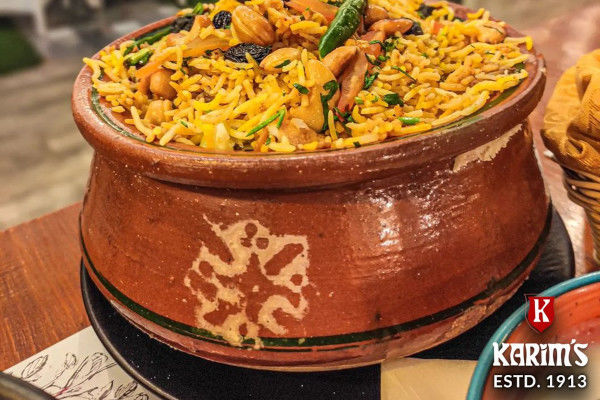Tête-À-Tea With Sachin Pabreja: An Insightful Conversation With Mr. Aivaz Asif, The New Generation Successor Of The Heritage Restaurant Chain – Karim’s (Estd. 1913)
Explore the 109-year-old legacy of Karim’s serving authentic Mughlai Cuisine
14 Mar, 2024 by Sachin Pabreja
I love how each dish tells a story, it’s like a cultural experience on a plate. The Mughal cuisine at Karim’s is renowned for its richness, complexity, and exquisite flavours. It’s a culinary tradition that reflects the opulence and refinement of the Mughal Empire. My personal experience is second to none!

1.Can you share stories or anecdotes about the historical significance of your restaurant’s operation?
In the heart of Delhi, a culinary legacy was born in the mid-19th century, shaped by the hands of Haji Karimuddin, a skilled cook in the royal court of the Mughal Emperor. However, destiny took an unexpected turn when Bahadur Shah Zafar faced exile, prompting Karimuddin to leave the city for Meerut and later Ghaziabad.
Haji Karimuddin's vision materialized in the form of a humble Dhaba, where he introduced a menu featuring just two items – Alu Gosht (mutton with potatoes) and Daal (lentil curry), served with the delicate and thin Rumali Roti. The aromatic spices and authentic preparation quickly garnered attention, making the Dhaba an instant hit among locals and visitors alike.
The success of the Dhaba paved the way for a more permanent establishment, and in 1913, Haji Karimuddin proudly inaugurated the Karim Hotel in Gali Kababian, near Jama Masjid, Delhi. With a mission to "earn fame and money by serving the royal food to the common man," the Karim Hotel became synonymous with Mughlai culinary excellence.
As decades passed, the legacy expanded, embracing new locations across Delhi and the NCR region. The first branch opened in the 1990s in Nizamuddin West, followed by establishments in Kailash Colony, Noida, Gurgaon, Kamla Nagar, and Dwarka. Today, the fourth generation of the Karim family continues to uphold the culinary traditions and standards set by their forefathers.
At Karim Hotels Pvt. Ltd., located at Jama Masjid, and the restaurant named Dastar Khwan-E-Karim in Nizamuddin West, New Delhi, we take pride in offering a taste of history, where every dish carries the essence of a bygone era while catering to the diverse palates of modern India.

2. How do you incorporate storytelling into the dining experience, sharing the narrative background of certain dishes or culinary traditions with your customers?
At our restaurant, storytelling is an integral part of the dining experience, allowing us to weave a rich tapestry of history and culture around each dish. Here's how we incorporate storytelling into the culinary journey for our customers:
Each dish on our menu is accompanied by a brief narrative that delves into its historical origins, cultural significance, or the inspiration behind its creation.
By providing context for the dish, we aim to engage diners on a deeper level, fostering a connection between the food they're about to enjoy and the cultural stories that surround it.
Interactive Servers:
Our trained staff members are equipped with the knowledge to share anecdotes about specific dishes, ingredients, or cooking techniques with customers.
Servers actively encourage diners to ask questions, creating a more interactive and personalized dining experience.
Our restaurant features visual displays, such as photographs, artwork, or artifacts, that complement the stories behind the dishes.
These visual elements serve as a tangible connection to the cultural and historical contexts, enhancing the overall sensory experience.
Storytelling Through Ambiance:
The restaurant's ambience, decor, and music contribute to the storytelling atmosphere. The design elements may reflect the historical period or cultural theme associated with certain dishes.
By intertwining storytelling with the dining experience, we aim to create a memorable and immersive journey for our customers, where each dish becomes a chapter in the larger narrative of culinary history and tradition.

3. Can you share any significant inspirations or traditions that you’ve incorporated into the ambience or culinary offerings of your restaurant?
Certainly! At our restaurant, we take pride in incorporating significant inspirations and traditions into both the ambience and culinary offerings, creating a unique and immersive dining experience. Here are some examples:
Our restaurant is adorned with carefully curated cultural artifacts that reflect the historical and culinary traditions we celebrate. These artifacts may include paintings, sculptures, or traditional crafts from the regions that inspire our cuisine.
The decor is designed to transport diners to a specific time or place, embracing the visual elements of the cultures that influence our culinary offerings. This can include thematic wall coverings, lighting, and furniture that resonate with the ambience we aim to create.
We pride ourselves on preserving and sharing authentic family recipes passed down through generations. These recipes often come with their own stories, creating a sense of heritage and nostalgia for our diners.
By blending these inspirations into our restaurant's ambience and culinary offerings, we aim to offer a holistic experience that goes beyond just a meal. It's a journey through time, culture, and flavor, providing diners with a unique and memorable dining adventure.

4. In what ways does your restaurant contribute to preserving and promoting the culinary heritage of your restaurant
Our restaurant is deeply committed to preserving and promoting the culinary heritage we hold dear. Here are several ways in which we actively contribute to this mission:
We prioritize the use of authentic recipes passed down through generations, ensuring that each dish maintains its traditional flavours and preparation methods. This commitment helps preserve the original essence of the cuisine.
Each item on our menu is accompanied by a brief narrative that shares the historical context, cultural significance, or familial story behind the dish. This storytelling approach helps diners connect with the culinary heritage and understand the roots of what they are enjoying.
We actively promote and practice traditional culinary techniques that may be at risk of fading away. From slow-cooking methods to artisanal preparation styles, our kitchen embraces these techniques to ensure the authenticity of our offerings.
We maintain a comprehensive archive documenting the history of our restaurant, including the evolution of our menu, culinary techniques, and the stories behind each dish. This documentation serves as a valuable resource for future generations.
By actively engaging in these initiatives, our restaurant strives not only to preserve the culinary heritage we cherish but also to share it with the community, fostering a deeper appreciation for the richness of our culinary traditions.

5. What steps have you taken to adapt to changing cultural and culinary trends, ensuring that your restaurant remains relevant and appealing to the evolving tastes of the new generation?
Adapting to changing cultural and culinary trends is essential for staying relevant and appealing to evolving tastes. Here are several steps our restaurant has taken to ensure that we remain in tune with the preferences of the new generation:
Collaborations with guest chefs, especially those known for pushing culinary boundaries, bring a fresh perspective to our kitchen. These collaborations introduce our patrons to new culinary trends and techniques.
Maintaining an active presence on social media platforms allows us to connect with a younger audience. We share behind-the-scenes glimpses, cooking tutorials, and interactive content to stay engaged with our community.
While preserving our culinary heritage, we also embrace cultural fusion by incorporating elements from diverse cuisines. This approach appeals to the adventurous tastes of the new generation while respecting the authenticity of each dish.
Responding to the increasing demand for sustainable practices, we have implemented initiatives such as sourcing locally, reducing food waste, and minimizing our environmental footprint. This resonates with the values of environmentally conscious consumers.
Regularly seeking feedback from customers through surveys, social media, and direct interactions allows us to understand evolving preferences. This feedback loop informs menu adjustments and overall restaurant strategies.
Partnering with food influencers and bloggers helps us reach a broader audience and allows us to tap into emerging trends that resonate with the younger demographic.
Our kitchen and service staff undergo continuous training to stay updated on culinary trends, new ingredients, and innovative cooking methods. This ensures that our team is well-equipped to deliver a contemporary dining experience.
By taking these steps, our restaurant remains adaptable and attractive to the changing tastes and expectations of the new generation, ensuring that we continue to thrive in the dynamic culinary landscape.
Personal Questions:
6. Are there specific values or principles that guide your decision-making as a restaurant owner, reflecting your personal ethos?
Upholding the authenticity of culinary traditions is a fundamental principle. This involves sourcing high-quality, authentic ingredients and maintaining traditional cooking methods to ensure an exceptional dining experience.
Community Engagement:
Building a strong connection with the local community is a core value. This may involve participating in local events, supporting community initiatives, and fostering a welcoming environment that reflects the diverse backgrounds of the patrons.
Operating with a commitment to sustainability by sourcing locally, reducing waste, and implementing eco-friendly practices. This reflects a responsibility not only to the environment but also to the long-term health and well-being of the community.
Continuous Improvement:
Embracing a culture of continuous improvement in all aspects of the restaurant, from the menu to service and operations. This involves regularly seeking feedback, staying abreast of culinary trends, and investing in staff training and development.
Prioritizing a passion for quality in every aspect of the restaurant, from the ingredients used to the presentation of dishes. This commitment to excellence creates a memorable and consistent experience for customers.
Recognizing the dynamic nature of the culinary industry and being open to adaptation. This involves staying flexible in response to changing customer preferences, emerging food trends, and unforeseen challenges.
Prioritizing the well-being and professional development of the restaurant staff. This includes creating a positive work environment, providing training opportunities, and acknowledging the crucial role each team member plays in the success of the establishment.
Customer-Centric Approach:
Adopting a customer-centric approach by understanding and exceeding customer expectations. This involves active listening, incorporating customer feedback into decision-making, and ensuring a consistently exceptional dining experience.

7. How do you stay creatively inspired and innovative in your approach to food and hospitality, bringing your personal touch to the dining experience?
Staying creatively inspired and innovative in the realm of food and hospitality is crucial for offering a unique and memorable dining experience. Here are some strategies to infuse your personal touch and maintain a spirit of creativity in your approach:
Collaborate with other chefs, mixologists, and culinary experts. Networking within the industry can lead to inspiring collaborations, shared knowledge, and a cross-pollination of ideas that bring a unique flair to your offerings.
Pay attention to customer feedback and preferences. Understanding your patrons' tastes and adapting your menu accordingly ensures that you stay relevant and responsive to the evolving desires of your target audience.

8. As a new-generation restaurant owner, how do you see your role evolving in the future, and what personal aspirations do you have for the continued growth of your restaurant?
As a new-generation restaurant owner, envisioning the future role of your establishment involves a strategic blend of innovation, adaptability, and a commitment to evolving customer expectations. Here are some perspectives on the evolving role of a restaurant owner and potential personal aspirations for the continued growth of your restaurant:
Embrace technology to enhance the customer experience. Explore online reservation systems, digital menus, and engagement through social media platforms. A strong digital presence can expand your reach and keep your restaurant top-of-mind for tech-savvy patrons.
Prioritize sustainability initiatives and social responsibility. Align your restaurant with eco-friendly practices, such as reducing waste, sourcing locally, and supporting community causes. A commitment to ethical business practices can resonate with socially conscious consumers.
Engage in collaborations with other businesses or chefs, and consider hosting pop-up events. These initiatives can introduce fresh perspectives, attract new customers, and create buzz around your restaurant.
Experiment with innovative marketing strategies. Utilize influencer partnerships, experiential marketing, and immersive campaigns to engage with your target audience. A creative and forward-thinking approach to marketing can set your restaurant apart in a competitive market.
Embrace data-driven decision-making. Leverage customer feedback, sales data, and market trends to inform your business strategies. Analytics can provide valuable insights into customer preferences, helping you refine your offerings and improve operational efficiency.
Be open to adaptive business models. Explore takeout and delivery options, subscription services, or virtual kitchen concepts. Flexibility in your business model can help you navigate changes in consumer behaviour and market dynamics.
Prioritize the well-being of your staff and invest in ongoing training programs. A motivated and well-trained team contributes to a positive work environment and ensures consistent quality in both service and culinary offerings.
Offering a diverse selection of dishes to explore at Karim’s, now is the perfect time to indulge in some culinary curiosity allowing you to immerse yourself in the rich flavors of Mughlai cuisine as you celebrate Ramadan!
Written By
A hotelier and restauranteur with more than two decades of experience in the F&B and Hospitality industries, Sachin Pabreja is Co-founder of EazyDiner, India’s only instant table reservation platform. He is passionate about changing the landscape of the Indian F&B industry. Prior to EazyDiner, Sachin worked at The Imperial, Grand Hyatt as well as Claridges Hotel in New Delhi and remains focussed and committed to creating innovative and exceptional products in the F&B and Hospitality industries.

